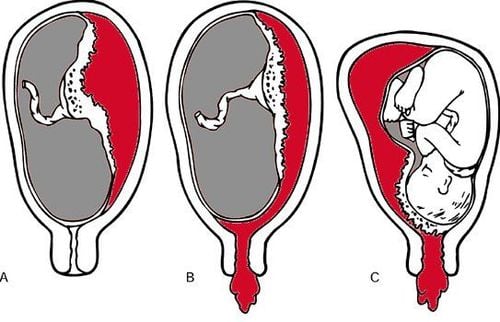This is an automatically translated article.
The article was professionally consulted by Dr. Nguyen Anh Tu - Doctor of Obstetric Ultrasound - Prenatal Diagnosis - Obstetrics Department - Vinmec Hai Phong International General Hospital.Almost any pregnant woman when going to a prenatal check-up is also suggested to measure the AFI index - amniotic fluid index to monitor how much amniotic fluid she has, in case of lack or excess of amniotic fluid during pregnancy. In particular, the state of pregnancy at 31 weeks of polyhydramnios or polyhydramnios at 32 weeks, and 35 weeks of excess amniotic fluid all affect the fetus and mother more or less.
1. What is polyhydramnios?
Amniotic fluid is a fluid composed of urine, secretions from the fetal lungs, the mother's circulatory system, from the endothelium, and diffuses through the umbilical cord. Amniotic fluid helps to regenerate energy, providing nutrients necessary for the existence and development of the fetus. Helps the fetus avoid excessive compression caused by the uterine muscles and protects the fetus from the invasion of foreign bacteria. Normally, the amount of amniotic fluid has different levels of assessment:From 16 - 32 weeks Age: Amniotic fluid is considered normal if it reaches 250 - 600ml From 34 weeks of age, amniotic fluid will increase to about 800ml and maintain until 36 weeks of pregnancy, it will reach the highest level of 1000ml. After that, the amniotic fluid will gradually decrease to about 600-800ml around the time before labor. However, when there are some abnormalities in the mother, the amniotic fluid level is two to three times higher than normal. Sometimes, this condition is called excess amniotic fluid during pregnancy.
1.1 Causes of excess amniotic fluid during pregnancy Polyhydramnios in pregnant women often stems from 4 main causes:
Mother has diabetes: According to statistics, up to 10% of pregnant women have gestational diabetes This can lead to polyhydramnios during pregnancy. Mothers with diabetes are also at increased risk of having a large baby.

Mothers carrying twins or multiples : Having multiple pregnancies can cause the metabolism of the two fetuses to be unbalanced, one fetus has more amniotic fluid while the other fetus has less amniotic fluid. Fetal abnormalities: The fetus stops swallowing amniotic fluid leading to polyhydramnios. Usually this condition occurs when the fetus has malformations such as: Cleft palate, pyloric stenosis... Other factors: Some factors that increase polyhydramnios are anemia or fetal infection. , blood group difference between mother and baby... Note: Usually pregnant women will have polyhydramnios at 30 weeks onwards (eg: 32 weeks polyhydramnios, 35 weeks polyhydramnios ..), but also Some women have polyhydramnios as early as 20 weeks of pregnancy.
1.2 Is polyhydramnios dangerous? Polyhydramnios, if severe, can cause fetal death. In addition, polyhydramnios at 31-35 weeks gestation can increase some risks such as:
Preterm birth: If the amount of fluid in the womb is too large, affecting the ability of the cervix to endure, it can lead to to premature rupture of membranes, premature birth. Retrograde birth: Excessive amniotic fluid makes it difficult for the baby to turn its head down in the last weeks of pregnancy. The mother may be indicated for an interventional cesarean section and has more risks than a normal vaginal birth. Vaginal bleeding and other complications involving the mother's uterus (postpartum haemorrhage). The reason is that the uterus has reduced elastic force and cannot fully contract as usual.
2. Method of diagnosis and treatment
When you suspect that you have signs of excess amniotic fluid during pregnancy, the first thing you need to do is visit your doctor to check and accurately diagnose the extent of pregnancy polyhydramnios. You may be assigned to do some tests such as: blood sugar test, ultrasound, chromosome test, ... to have a basis to detect abnormal signs of health of mother and fetus .If you have polyhydramnios at 32 weeks onwards, the best way is to maintain antenatal care every 2 weeks, until 36 weeks pregnant, then shorten it to once a week. If you have gestational diabetes, you should check and measure the fetal heart rate twice a week. If the cause has been identified, the condition of excess amniotic fluid during pregnancy, depending on the levels, the doctor will have a method. appropriate treatment plan.Doctors will evaluate the signs of early labor to recommend early admission to the hospital. In some cases, a pregnant woman will be indicated for a cesarean section (eg, twin pregnancy, the fetus is horizontal, the fetus is not in a particular position...)
In general, the mother does not should be overly concerned because most pregnant women with excess amniotic fluid give birth to healthy babies, especially if the condition is mild. The most important thing is that pregnant women need to pay attention to monitor their health from week 31 to 35 of pregnancy onwards so that they can soon have appropriate prevention or treatment methods.

Vinmec International General Hospital offers a Package Maternity Care Program for pregnant women right from the first months of pregnancy with full antenatal check-ups, periodical 3D and 4D ultrasounds and routine tests to ensure that the mother is healthy and the fetus is developing comprehensively. Pregnant women will be consulted and checked for health under the close supervision of experienced and specialized obstetricians, helping mothers have more knowledge to protect their health during pregnancy as well as minimize complications affecting mother and child.
Please dial HOTLINE for more information or register for an appointment HERE. Download MyVinmec app to make appointments faster and to manage your bookings easily.














